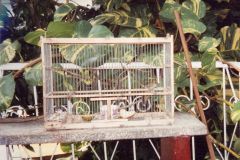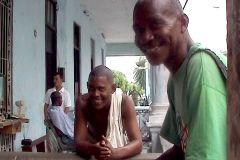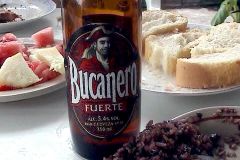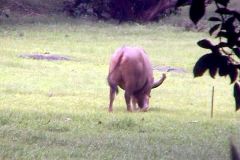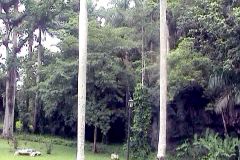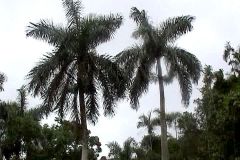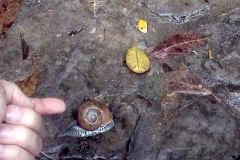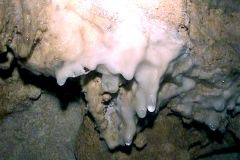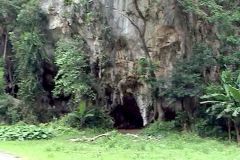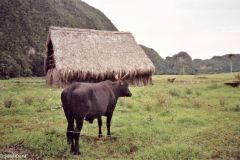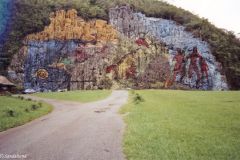Pinar del Rio and the Viñales valley quickly became favourite places. Find a beautiful country, and an emerging private economy, in this chapter two of my Cuba journey.
This is one of six articles from a visit to Cuba in 2003.
Wednesday 25.6.2003, Havana, Pinar del Rio
We had to get up early to catch the morning bus to Pinar del Rio right in the middle of beautiful western Cuba. At the station there were several people who wanted to have us with them in a taxi or collectivo. One mentioned 15 USD.
I was however uncertain about it and chose to enter the dollar office. There were lots of backpackers in there and they were for the most part going east to Varadero, the biggest resort in Cuba. Our AC bus cost me 17 USD and left an hour later. Several others were already onboard, only dollar tourists going to Viñales. Comfortable standard.
Flat landscape along the motorway, mountains in the background. Lush. At all crossings on the way there were lots of Cubans sitting and waiting for a lift, apparently endlessly. Our dollar coach was evidently out of reach for the ordinary Cuban.
.
In Pinar we stepped out of the bus and were met by 7-8 eager guys behind a high mesh fence waiving their business cards. It was all about private accommodation, i.e. casa particular. We joined two of them and chose the latter out of space and window views. 15 USD plus 3 for breakfast.
The family, father, mother and daughter at five, were nice and spoke some English. The father was an ex professional boxer and the mother was an English teacher in primary school. The father was Syrian two generations back and went under the name El Morro (the Moor). He was a typical fixer. He fixed a day trip to the magnificent Viñales valley tomorrow, he fixed a very good (and expensive) lunch at a friend’s place, the same with a hairdresser, a tour to a cigar plantation, and dinner in his own home! Money in circulation gives dividends. Fair enough.
Private enterprise is being reinvented in Cuba. This was in fact a major reason to come here now: To see the Cuba as it has been since the revolution, before it opens up fully to dollar tourism in a few years time. For good or for worse?
The haircut was fun. Two hairdressers had rolled out two chairs on the wide pavement. A little table for saxes and a mirror hung on a hook in the window. We had a haircut both of us, with a very good result. A dollar each just had to be rounded up to a total of three. An experience!
.
Two compañeros of el Morro drove us out to a large cigar plantation. It belongs to the sole surviving Cuban with a cigar brand named after him – Robaina – an elderly gentleman at 83 years of age. Unfortunately it was outside the season and they only had a few plants and leaves to show us. The tour was made by a man who called himself PR manager and spoke with a distinct American accent. How did he get it, I wondered. We were shown cuttings and told how they were replanted, grew to 2 metres height before the leaves were cut and bundled. After that they hang to dry for a few weeks. Further on in the process there is a sorting and fermenting process in heaps another few weeks until everything is sent to the cigar factories, most of them in Havana.
Most of Cuba’s tobacco production takes place in this western province. This farm has at the peak of the season 120-130 labourers and uses 17 large barns for the drying process.
We were allowed to meet the old man and as he liked my son I got a fine cigar. It was enjoyed after dinner. Which by the way was good. The room as well, apart from ants.
Spent: 80 USD (The rest of the vacation: Accommodation and breakfast are counted on the day we get up.)
Thursday 26.6.2003, Viñales & Pinar del Rio
Right after yet a good breakfast with lots of fruit, we took off towards the Viñales valley in the middle of the mountains. Not the biggest mountains admittedly, but mountains nonetheless. Grand and lush. Especially the large royal palms, also apparent on Cuba’s coat of arms, are impressive. The small farms seem poor, as do los campesinos with their well-used clothes and machetes.
Everywhere they grow maize, coconut palms, mango trees, bananas…
We drove through the village of Viñales, a rather long stretched affair with plenty of overnight stays of the private sort. Mainly one-storey buildings.
Our first stop was Cueva del Indio, the Indian grotto (3 USD). First we walked into a modestly lightened corridor of a couple of hundred metres, and then carried a bit longer in a boat in intense darkness. Unfortunately the boat was motorised.
.
The next stop was Cueva de San Miguel (1 USD). Here we had a walk with an English speaking guide. This grotto was in the 1800s used as a refuge for fleeing slaves. We saw some replicas on the other side. We went 300 metres around the mountain and had a look at some vultures.
Later we went up to the very strange Mural de la Prehistoria as seen on the picture above. An artist have painted dinosaurs directly on the side of a mountain. This kind of graffiti is huge.
The last stop was the view point over the valley, next to a hotel with pool. It would have been a nice place to stay the night, because all the postcard pictures from Viñales are taken from here. I found out that bargaining for official souvenirs was not possible.
The trip cost us 35 USD and lasted almost the whole day. (The driver was the brother of El Morro. Surprise!) We bought postcards on the return and had our dinner “home” (yet a not so surprising result given our persuasive host).
Spent: 75 USD.
A visit to the lush valley of Vinales in Cuba. The valley is on UNESCO’s World Heritage List.
Friday 27.6.2003, Pinar del Rio
Now what to do? Our plans are not that fixed!
A 70 km excursion to the sea with swimming was dropped because of distance and the cost of 50 USD. Instead we spent several hours in our room and the town doing little or nothing at all.
I bought cigars for about 70 USD, much more than planned, in an official cigar store.
We are constantly approached by gentlemen on the street with an interest in cigar sales. They all know someone…
.
Strangely we had payment problems when we sent our postcards back home. We did not have pesos to pay for the stamps! An elderly gentleman had mercy on us. Tragic for 3 pesos (less than 15 US cents). This is how it gets when moving with the flood in the black economy.
We ate a good dinner at a private restaurant (paladar). A man passed us up on the street and we agreed to letting him drive us to Havana in the morning the next day. The idea is to catch a Viazul bus at 1300 hours. As there is no ordinary bus going to Havana we had to take a taxi or collectivo. The price would be 8 USD if my son sat on my lap. This gent was clearly angry at our house lord with his gold chains who always took care to put profits in his own pocket…
Spent: 60 USD + 70 USD in cigars.
Further reading
(1) Havana: Cuba as it is, with Fidel still alive, and the system working as it has done since the revolution. That is what I wanted to find on my three week trip to this intriguing island in the sun. Did I find it? My conclusion follows at the end of this story in five chapters.
(2) Pinar del Rio and the Viñales valley: A beautiful country, and an emerging private economy is found in this chapter two of my Cuba journey.
NEXT CHAPTER: (3) From Cienfuegos to Trinidad: Chapter three is about lazy days on the beach, colonial mansions and a flat tire in the middle of nowhere.
(4) Trinidad: A most wonderful town and surroundings rich in slave history. This is chapter four of my Cuban experience.
(5) Camaguëy, Playas del Este: A journey full of hassles, stripped memories and concluding remarks of my three weeks in Cuba. Those are the key words of this last chapter from Cuba.
PICS – Cuba: All images from Cuba in one place.
A photographic remark: My camera was stolen on the last day of my visit along with the memory card(s). The pictures featured in this series from Cuba are stills captured from my video. Hence the rather poor quality. My camcorder was also stolen but I kept the first film separately so I was able to keep at least some photographic evidence of the trip. Read more in the last part of this trip.

